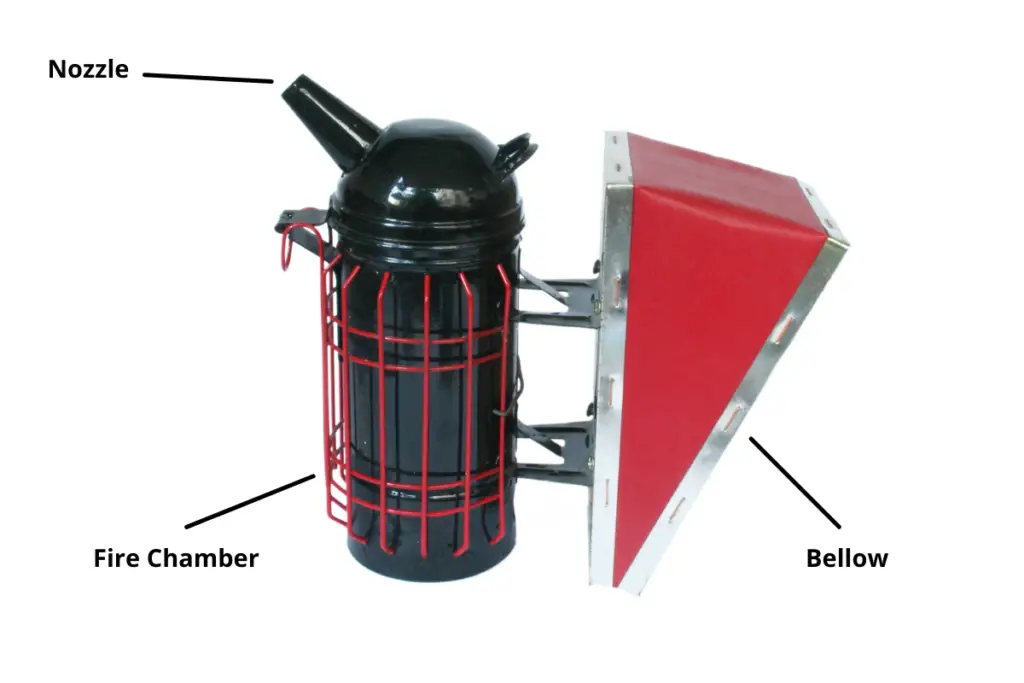Smoking bees is the primary technique beekeepers use to manage their colonies during inspections and honey harvesting.
But what does the smoke really do to the bees? In this post, we cover the ins and outs of the bee smoker and just how important it has been for beekeeping and honey production.
What Is A Bee Smoker?
A bee smoker is a tool beekeepers use to puff smoke in and around the honey supers and brood boxes. Referred as ‘smokers’ in the apiary community, it contains three primary parts;
- Bellow – controls the level of oxygen in the smoker and puffs the smoke out
- Nozzle – the tip from which smoke is puffed out
- Fire Chamber – the area in which burlap, pine needles, wood pellets, twigs, or cardboard smolders create smoke
Fun Fact: The Sun Temple of Nyuserre Ini, an ancient Egyptian Pharoh, depicts the practice of using smoke to domesticate honeybees. It wasn’t until 1873, that Moses Quinby, the father of American beekeeping, introduced the bee smoker as we are familiar with today.

What Does Smoke Do To Bees?
Put short; smoke placates bees using two approaches. It hinders their sense of smell and initiates their survival tactic.
Smoke Overpowers Pheromones
In reality, beekeepers confirm sensing a unique smell like banana oil when approaching bee colonies. But experts explain it better; guard bees secrete alarm pheromones (isopentyl acetate and 2-heptanone) to alert the stingers and worker bees of an intrusion into their bee colonies.
However, the smoke overpowers the pheromone and interferes with the bees’ sense of smell.
(2 Antennaae house thousands of sensory organs)
Thus, the bees cannot communicate and prepare for an attack against the intruder; instead, they opt for a survival mode.
The other pheromone bees can sense is the human fear pheromone which causes bees to become aggressive. Click here to learn more about the bee’s amazing sense of fear.
Using Survival Instincts To Your Advantage
The beekeeper’s smoke fools the worker bees to perceive a fire threat that might destroy their home. So, the bees assume they have to leave their habitat and look for a new home.
Before leaving the hive, the bees store as much honey as possible to start a new home in their stomachs. It overwhelms their abdomens with honey which pacifies their sting ability.
Then, the bees leave the beehive peacefully without intending to harm the beekeeper.
As a result, beekeepers find using smoke the cheapest and most effective way to drive out bees from beehives. Additionally, it is the safest way to calm bees and prevent bee stings.
How Do Bee Smokers Work?
For the bee smoker to light up quickly and produce smoke consistently, you will need two types of fuel materials, a starter and kindling.
Kindling is a bee smoker fuel that lights up fast and burns gradually while producing smoke, whereas a starter is used to light the kindling.
You can use newspapers or pine cones as starters while using pine needles, burlap, wood shavings or wood chips, cardboard, or dried cow manure as kindling.
You should avoid using synthetic materials or bleached paper to enrage the bees. The same applies to using fuels with chemical odors as they can harm the bees, including yourself, by inhaling toxic compounds.
Lighting the Bee Smoker
Identify your starter, crumple it, and light it up. Put the burning starter into the stainless steel tin burner and smoothly pump the bellows several times to let oxygen into the blazing starter. You will observe puffs of smoke through the sprout.
Then add enough kindling on top of the burning starter in the fire chamber. Begin pumping the bellows again until you see a significant amount of smoke released. Also, listen out for the sound of the kindling igniting correctly.
It would be best to confirm there is unrestricted airflow from the bellows. It ensures your bee smoker continues to burn the kindling and produce cool smoke for a more extended period.

